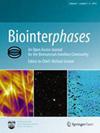使用原子力显微镜对细胞外基质蛋白质进行分子水平的研究。
IF 1.9
4区 医学
Q4 BIOPHYSICS
引用次数: 0
摘要
细胞外基质(ECM)蛋白为人体细胞和组织提供锚定和结构强度,因此是细胞增殖、生长和功能过程的基本分子成分。原子力显微镜(AFM)已逐渐成为在单个分子水平上研究 ECM 蛋白等生物分子的重要方法。原子力显微镜的操作模式可用于测量样品的物理、电子和机械特性,以及观察样品表面化学的复杂细节。在纳米尺度上研究生物分子的形态和特性有助于了解 ECM 蛋白质与生物分子(如细胞、DNA 和其他蛋白质)之间的相互作用。制备用于原子力显微镜研究的蛋白质样品的方法只需一些基本步骤,例如将基底浸入稀释溶液或蛋白质中,或将蛋白质悬浮液的液滴沉积在平坦、洁净的表面上。纳米光刻技术已被用于确定原子力显微镜研究中蛋白质的排列。利用原子力显微镜,可以在环境或水环境中使用涂有 ECM 蛋白质的针尖进行机械和力测量。本综述介绍了 AFM 研究的代表性实例,这些实例用于分子水平研究 ECM 蛋白质(胶原蛋白、弹性蛋白、纤连蛋白和层粘连蛋白)的结构、表面组装、蛋白质-细胞相互作用和机械性能。此外,还将讨论样品制备方法以及使用原子力显微镜进行表征的模式。本文章由计算机程序翻译,如有差异,请以英文原文为准。
Molecular-level studies of extracellular matrix proteins conducted using atomic force microscopy.
Extracellular matrix (ECM) proteins provide anchorage and structural strength to cells and tissues in the body and, thus, are fundamental molecular components for processes of cell proliferation, growth, and function. Atomic force microscopy (AFM) has increasingly become a valuable approach for studying biological molecules such as ECM proteins at the level of individual molecules. Operational modes of AFM can be used to acquire the measurements of the physical, electronic, and mechanical properties of samples, as well as for viewing the intricate details of the surface chemistry of samples. Investigations of the morphology and properties of biomolecules at the nanoscale can be useful for understanding the interactions between ECM proteins and biological molecules such as cells, DNA, and other proteins. Methods for preparing protein samples for AFM studies require only basic steps, such as the immersion of a substrate in a dilute solution or protein, or the deposition of liquid droplets of protein suspensions on a flat, clean surface. Protocols of nanolithography have been used to define the arrangement of proteins for AFM studies. Using AFM, mechanical and force measurements with tips that are coated with ECM proteins can be captured in ambient or aqueous environments. In this review, representative examples of AFM studies are described for molecular-level investigations of the structure, surface assembly, protein-cell interactions, and mechanical properties of ECM proteins (collagen, elastin, fibronectin, and laminin). Methods used for sample preparation as well as characterization with modes of AFM will be discussed.
求助全文
通过发布文献求助,成功后即可免费获取论文全文。
去求助
来源期刊

Biointerphases
生物-材料科学:生物材料
自引率
0.00%
发文量
35
期刊介绍:
Biointerphases emphasizes quantitative characterization of biomaterials and biological interfaces. As an interdisciplinary journal, a strong foundation of chemistry, physics, biology, engineering, theory, and/or modelling is incorporated into originated articles, reviews, and opinionated essays. In addition to regular submissions, the journal regularly features In Focus sections, targeted on specific topics and edited by experts in the field. Biointerphases is an international journal with excellence in scientific peer-review. Biointerphases is indexed in PubMed and the Science Citation Index (Clarivate Analytics). Accepted papers appear online immediately after proof processing and are uploaded to key citation sources daily. The journal is based on a mixed subscription and open-access model: Typically, authors can publish without any page charges but if the authors wish to publish open access, they can do so for a modest fee.
Topics include:
bio-surface modification
nano-bio interface
protein-surface interactions
cell-surface interactions
in vivo and in vitro systems
biofilms / biofouling
biosensors / biodiagnostics
bio on a chip
coatings
interface spectroscopy
biotribology / biorheology
molecular recognition
ambient diagnostic methods
interface modelling
adhesion phenomena.
 求助内容:
求助内容: 应助结果提醒方式:
应助结果提醒方式:


